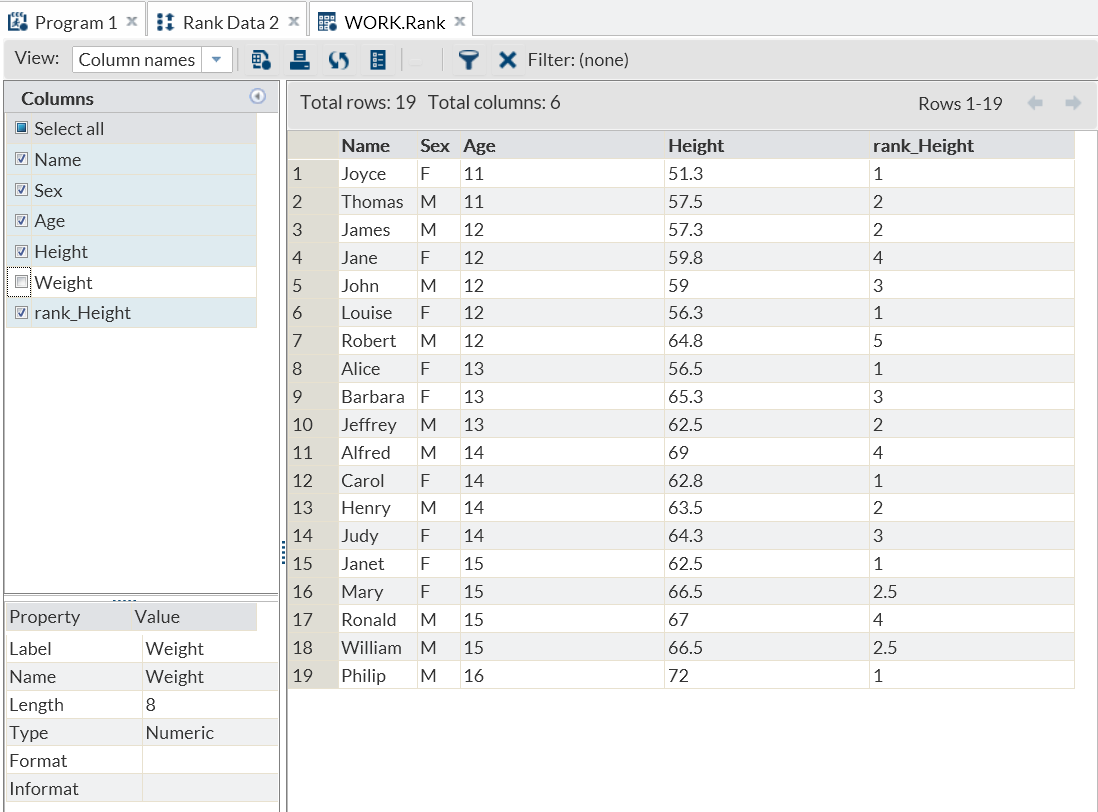Rank Data Task
About the Rank Data Task
The Rank Data task computes
ranks for one or more numeric variables across the rows in a table
and includes the ranks in an output table.
For example, you might
want to rank the sales for each product that your company sells. In
this case, the ranking variable would show the order of product sales.
The product with the highest number of sales would be ranked first.
Example: Ranking Students by Age and Height
In this example, you
want to rank the students in your class by age and height.
To create this example:
The Rank Data task creates
an output data set. In SAS Studio, this data set opens on the WORK.Rank tab.
This data set contains the additional rank_Height column, which shows
where that student ranks within her age group. For example, in the
11-year-old age group, Joyce is ranked number one. In the 12-year-old
age group, Louise is ranked number 1.
Assigning Data to Roles
To run the Rank Data
task, you must assign a column to the Columns to rank role.
|
Role
|
Description
|
|---|---|
|
Columns
to rank
|
Each column that is
assigned to this role is ranked. You must assign at least one variable
to this role. By default, the rankings column is given the name rank_column-name,
where column-name is the name
of the original column.
|
|
Rank by
|
When you assign one
or more columns to this role, the input table is sorted by the selected
column or columns and rankings are calculated within each group.
|
Setting Options
You must select at
least one output option.
|
Option Name
|
Description
|
|---|---|
|
Options
|
|
|
Ranking
method
|
specifies the method
to use when ranking the data. Here are the valid values:
None
does not use a method
to rank the data.
Percentile ranks
partitions the original
values into 100 groups, in which the smallest values receive a percentile
value of 0 and the largest values receive a percentile value of 99.
Deciles
partitions the original
values into 10 groups, in which the smallest values receive a decile
value of 0 and the largest values receive a decile value of 9.
|
|
Ranking
method (continued)
|
Quartiles
partitions the original
values into four groups, in which the smallest values receive a quartile
value of 0 and the largest values receive a quartile value of 3.
Group = n (NTILES)
partitions the original
values into n groups, in which
the smallest values receive a value of 0 and the largest values receive
a value of n–1. Specify
the value of n in the Number
of groups box.
Fractional ranks with denominator = n
computes fractional
ranks by dividing each rank by the number of observations that have
nonmissing values of the ranking variable.
Fractional ranks with denominator = n+1
computes fractional
ranks by dividing each rank by the denominator n+1,
where n is the number of observations
that have nonmissing values of the ranking variable.
Percents
divides each rank by
the number of observations that have nonmissing values of the variable
and multiplies the result by 100 to get a percentage.
|
|
Ranking
method (continued)
|
Normal scores (Blom formula), Normal
scores (Tukey formula), Normal scores (van
der Waerden formula)
computes normal scores
from the ranks. The resulting variables appear normally distributed.
Here are the formulas:
Blom formula
 Tukey formula
 van der Waerden
 In these formulas,
 is the inverse cumulative normal (PROBIT) function, ri is
the rank of the ith observation, and n is
the number of nonmissing observations for the ranking variable. is the inverse cumulative normal (PROBIT) function, ri is
the rank of the ith observation, and n is
the number of nonmissing observations for the ranking variable.
Note: If you set the If
values tie, use option, the Rank Data task computes the
normal score from the ranks based on non-tied values and applies the
ties specification to the resulting score.
Savage scores (exponential)
computes Savage (or
exponential) scores from the ranks.
Note: If you set the If
values tie, use option, the Rank Data task computes the
Savage score from the ranks based on non-tied values and applies the
ties specification to the resulting score.
|
|
If values
tie, use:
|
specifies how to compute
normal scores or ranks for tied data values.
Mean (Midrank)
assigns the mean of
the corresponding rank or normal scores
High rank
assigns the largest
of the corresponding ranks or normal scores
Low rank
assigns the smallest
of the corresponding ranks or normal scores
Dense rank
computes scores and
ranks by treating tied values as a single-order statistic. For the
default method, ranks are consecutive integers that begin with the
number one and end with the number of unique, nonmissing values of
the variable that is being ranked. Tied values are assigned the same
rank.
|
|
Rank order
|
specifies whether to
list the values from smallest to largest or from largest to smallest.
|
|
Results
|
|
|
Location
to save output data
|
specifies the location
of the output table. By default, the table is saved in the temporary
Work library.
|
|
Include
ranked columns
|
specifies that the output
table contains the original columns as well as the ranked columns.
If you want to replace the original column with the ranked columns,
deselect the Include ranking columns check
box.
By default, the ranked
column is given the name rank_column-name,
where column-name is the name
of the original column.
|
Copyright © SAS Institute Inc. All rights reserved.

